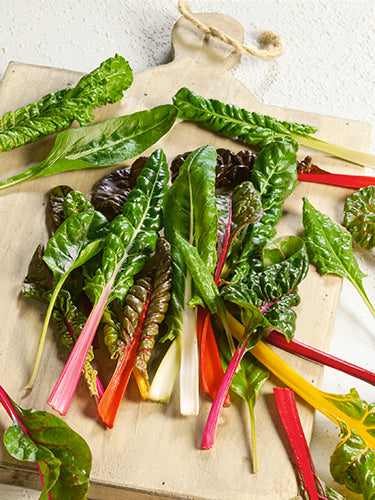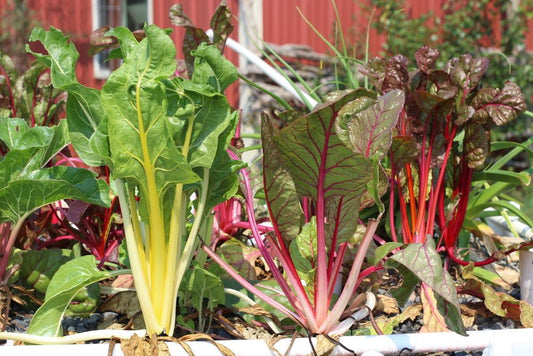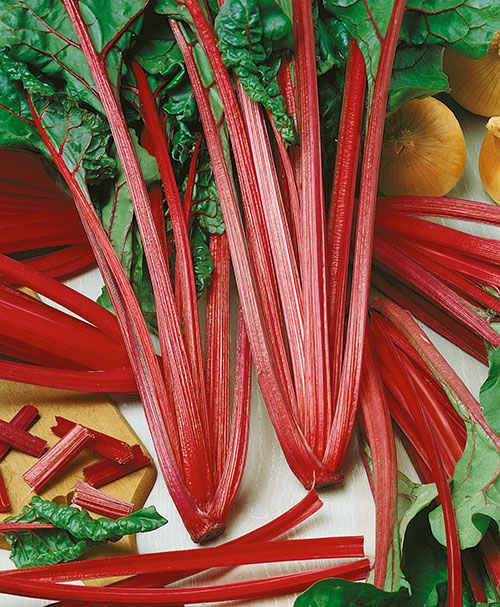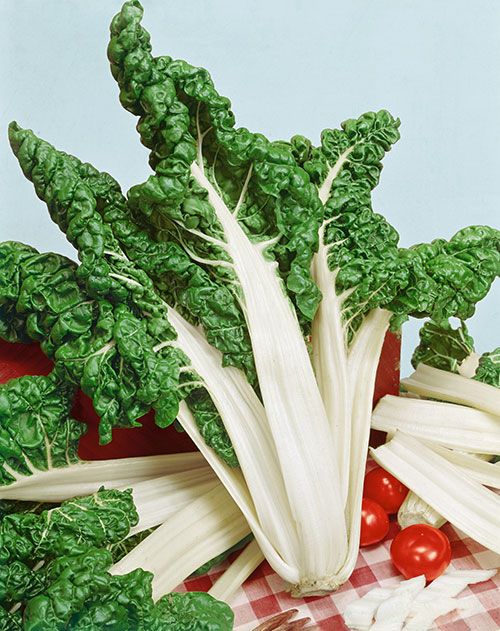-
Perpetual Swiss Chard
Regular price From $2.75 USDRegular priceUnit price per -
Rainbow Swiss Chard
Regular price From $2.45 USDRegular priceUnit price per -
Bright Lights Swiss Chard
Regular price From $2.95 USDRegular priceUnit price per -
Ruby Red Swiss Chard
Regular price From $2.92 USDRegular priceUnit price per -
Barese Swiss Chard
Regular price From $2.45 USDRegular priceUnit price per -
Fordhook Giant Swiss Chard
Regular price From $2.86 USDRegular priceUnit price per
Chard has many uses. Young, tender leaves are eaten fresh as a salad green, or mature leaves can be cook as you would spinach — steamed, boiled or sautéed in a little butter. You might also want to try them "Southern-style" serving them up with bit of butter, vinegar, and crumbled bacon.
The stalks, after being striped of leaves, can be used fresh as an interesting addition to a vegetable platter. They can also be prepared as mentioned above and served alone or mixed with the leaves. If your diet allows, battered and deep fried chunks are a tasty and decadent treat.
In spite of its high nutritional value and usefulness, Swiss Chard is not widely cultivated commercially.
As soon as the soil can be worked in early spring, in a location that has well-drained soil and receives about eight hours of full sun daily, sow seeds ½-inch deep and one to two inches apart in rows spaced 12 to 24 inches apart.
Cover the seeds with loose soil and keep moist, making sure that they do not dry out, until seedlings appear. After that, water weekly (or as required in dry weather).
Poor stands are often the result of:
• Seeds planted too deeply.
• The soil has crusted over after watering or a heavy rain.
• Folks trying to be thrifty and not sowing enough seed. Although our seeds generally well exceed the Federal germination standard, which for Swiss Chard is 65%, beets can naturally exhibit low germination rates. Note that the seedlings tend to emerge over an extended period of time. This is not necessarily a bad thing as the result is a stand of different sizes and ages of seedlings for an extended harvest.
Care and Management:
Like their cousin, beets, Swiss Chard "seeds" are actually multi-germ seed balls with each having the potential of developing into one to five plants. Because of this, it is very important to thin your rows. When the plants reach 1½ to three inches in height, thin out the stand to one plant every eight inches so that the plants are not crowded and can develop properly.
Your "thinnings" can be eaten as "baby greens" in your salad mix or lightly steamed as greens. Keep well weeded. Cultivate shallowly, and often, to keep the soil loose around the developing plants.
NOTE: When thinning a plant cluster, do not pull as you will disturb and potentially damage the plant you wish to keep. Instead, use small scissors to snip off the plants you are removing. Additionally, do NOT attempt to separate into separate "seeds" as you will likely damage them and they will not be able to germinate.
Harvest Tips:
• Young and tender leaves are the best.
• As soon as the plants become established and sturdy, begin harvesting the outer leaves as soon as they reach the desired size.
• Do not over-harvest or damage the growing tip. The plant needs leaves to grow!
• Leaves can be continually harvested throughout the growing season until harsh weather kills the plants. In areas with mild climates, production into the winter is possible.
The stalks, after being striped of leaves, can be used fresh as an interesting addition to a vegetable platter. They can also be prepared as mentioned above and served alone or mixed with the leaves. If your diet allows, battered and deep fried chunks are a tasty and decadent treat.
In spite of its high nutritional value and usefulness, Swiss Chard is not widely cultivated commercially.
Cultivation Information
Planting:As soon as the soil can be worked in early spring, in a location that has well-drained soil and receives about eight hours of full sun daily, sow seeds ½-inch deep and one to two inches apart in rows spaced 12 to 24 inches apart.
Cover the seeds with loose soil and keep moist, making sure that they do not dry out, until seedlings appear. After that, water weekly (or as required in dry weather).
Poor stands are often the result of:
• Seeds planted too deeply.
• The soil has crusted over after watering or a heavy rain.
• Folks trying to be thrifty and not sowing enough seed. Although our seeds generally well exceed the Federal germination standard, which for Swiss Chard is 65%, beets can naturally exhibit low germination rates. Note that the seedlings tend to emerge over an extended period of time. This is not necessarily a bad thing as the result is a stand of different sizes and ages of seedlings for an extended harvest.
Care and Management:
Like their cousin, beets, Swiss Chard "seeds" are actually multi-germ seed balls with each having the potential of developing into one to five plants. Because of this, it is very important to thin your rows. When the plants reach 1½ to three inches in height, thin out the stand to one plant every eight inches so that the plants are not crowded and can develop properly.
Your "thinnings" can be eaten as "baby greens" in your salad mix or lightly steamed as greens. Keep well weeded. Cultivate shallowly, and often, to keep the soil loose around the developing plants.
NOTE: When thinning a plant cluster, do not pull as you will disturb and potentially damage the plant you wish to keep. Instead, use small scissors to snip off the plants you are removing. Additionally, do NOT attempt to separate into separate "seeds" as you will likely damage them and they will not be able to germinate.
Harvest Tips:
• Young and tender leaves are the best.
• As soon as the plants become established and sturdy, begin harvesting the outer leaves as soon as they reach the desired size.
• Do not over-harvest or damage the growing tip. The plant needs leaves to grow!
• Leaves can be continually harvested throughout the growing season until harsh weather kills the plants. In areas with mild climates, production into the winter is possible.






